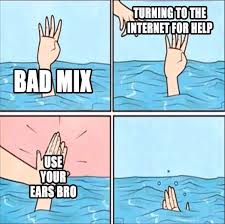It is (circuit-wise), yes. So it just visually resembles a shelf but doesn’t act like one, that makes sense ![]()
It is the shape of the EQ (looks like a shelf)

so the 10k freq of the knob would be the green circle (that one in picture is actually set at 5k) and as you turn it the shelf bit gets higher/lower
I must say that this is one of if not the best tutorials on how to eq your amp for a good live tone. Most of the tutorials are aimed at mixing/mastering and the ones that are aimed at EQing a live tone don’t go into enough detail describing what each part of the frequency sounds like, what problem it causes and how to resolve that. I always suggest that one of the best first pedals that someone can get is an EQ pedal.
This is one of my favourite music related memes:

I’m pretty lazy so i like to let iZotope plugins do most of the work when i’m playing around ![]() but i don’t play live
but i don’t play live ![]()
I can never remember which position is which so i just put it on the one that sounds best ![]()
One thing i like about that preamp is that it still has a tone knob that works in active mode.
Dude, I’m going to need you to dumb it down another 80% for me. I thought Q had to do with how narrow or wide is the range of the adjustment.
If you mean the width of the base of the bump, then I think I’m following.
It is (circuit-wise), yes. So it just visually resembles a shelf but doesn’t act like one, that makes sense
That makes no sense to me. How does it resemble a shelf but not act like one?
as you turn it the shelf bit gets higher/lower
Does this mean it sets a limit for anything 10kHz or above?
Not trying to be pedantic, I’m just having a hard time wrapping my head around this.
My initial assumption was that being a shelving EQ point would somehow make the fact it’s set at 10kHz, make sense for a bass amp.
Does this mean it sets a limit for anything 10kHz or above?
Not sure what you mean by limit in this context sorry…Shelving type just means it will boost or cut in the shelf shape as you turn the knob rather than boost/cut in another shape e.g. a bell shape.
In the picture of the shelf above all of the flat part of shelf is boosting those freqs by 3db.
My initial assumption was that being a shelving EQ point would somehow make the fact it’s set at 10kHz, make sense for a bass amp
Its probably meant as a cutting shelf for bass to try to get rid of amp/other hiss etc at 10k+…boosting might make your sound more ‘open’ in a best case scenario but for bass gat it would likely just boost hiss etc.
Dude, I’m going to need you to dumb it down another 80% for me. I thought Q had to do with how narrow or wide is the range of the adjustment.
For bandpass filters this is indeed the case. This is also how it presents in parametric EQ (which is really saying the same thing).
An ideal bandpass filter would pass basically just the center band and look kind of like one cycle if a square wave centered in the center frequency, or a line at the center frequency, depending on the band width. The Q factor determines the slope of the sides (i.e. how much it additionally spreads out from the peak).
An ideal low pass filter would look kind of like a single cycle of a square wave starting at 0Hz and ending at the cutoff frequency. The Q factor there determines how fast it falls off after the cutoff.
Another way to say all of the above, the Q-factor defines the shape of the resonant peak of the filter.
At least this is all my understanding. @DaveT can correct me if I am mistaken.
That makes no sense to me. How does it resemble a shelf but not act like one?
Because it’s at +/-0dB and you cannot raise or lower it (i.e. over the range it is flat it has no effect.).
A shelf can move up or down and will boost or cut all frequencies in the affected range.
So while the frequency response of a LPF and HPF visually resembles a shelf at 0dB, they do not otherwise act like one.
Right - what I am wondering is, electronically, how does it happen. I get that the cool chirpy and haloed resonance tone comes from the peak. What I am wondering is what causes the peak. Since there is a knob for it I am assuming resistance is involved in the circuit somehow and I am wondering how
I found the answer here myself and it totally does not fit within the context of a bass tone discussion- apologies for the diversion here ![]()
Aaaand here are the dwarves at work ![]() it’s brilliant - and quite easy too - once you know their names
it’s brilliant - and quite easy too - once you know their names ![]()
There was also some Edgy at first, but it doesn’t belong there. And it might need some more fine-tuning, but the good ingredients are all there. Now, let’s see how I can fit an HPF into the chain too ![]()
Thank you to everybody trying to answer my questions. I’m at the point of dispelling preconceived notions but I’m reading and trying to learn more.
Here’s a reference for the EQ points in the video.
- Tubby 80 Hz Bass
- Muddy 250 Hz Low Mid
- Honky 500 Hz Mid
- Bitey 1500 Hz High Mid
- Edgey 3000 Hz Treble
Just make a shirt that says “Josh Or Not” as those are the only two end states
Actually “Josh or Not” is kind of a killer band name.
We need a Schrodinger’s Josh. Is it Josh or Not Josh? Open the box and find out
Nothing about tone.
Your comment made me very happy.
That’s all.
Tone Dwarf is a pretty solid band name too
Medium Dwarf ![]()
it’s funny that this came out because i was having an interesting situation with eq that i felt kinda stupid about. my new darkglass infinity preamp has a hpf and lpf, centered at 50Hz and 500Hz. this made absolutely no sense to me, until i found out that darkglass doesn’t do their shelving in a traditional way, they choose ranges to apply distortion to. so you could have a dirt free low end but choose where you want the distortion to kick in. while i understand the theory in practice, in the real world this just makes my head hurt trying to figure it out. (why do you need two filters to do this, couldn’t you just say i want distortion above X frequency?). i will change the default settings to have the eq behave more like a standard 6 band eq.
Here’s a reference for the EQ points in the video.
- Tubby 80 Hz Bass
- Muddy 250 Hz Low Mid
- Honky 500 Hz Mid
- Bitey 1500 Hz High Mid
- Edgey 3000 Hz Treble
On my SVT-III (with more or less the old “Blueline” SVT-VR preamp), there are quite a lot of EQing options, including each Dwarf (approximately) :
Normal EQ :
The midrange frequency can be set to either 220 Hz, 450 Hz, 800 Hz, 1.6 kHz or 3 kHz. The bass and treble shelves are set to 40 Hz (!) and 4 kHz.
Voicing switches :
The Ultra high and Ultra low are set to 8 kHz and 600 Hz.
Switchable graphic EQ :
There are 6 bands, centered at 100 Hz, 250 Hz, 750 Hz, 2 kHz, and a low and high shelves. (but this is not an excellent graphic EQ, I must say. I don’t use it for now)
My way of using it is very old-school : I don’t use the graphic EQ at all (but I’m happy to have it, just in case I have to correct something quickly, it’s a big Dwarf-security), and I don’t use the voicing switches. I try to create my tone with only the Bass and Treble knobs of the normal EQ, like I would do on a good’ol B15. The midrange section, with its selectable frequency, allows me to correct easily any Dwarf frequency, for example if I use a different bass with more bite than usual.
Even without the graphic EQ, I think that the SVT EQ (with the 5-band selectable midrange frequency) is really well designed.
Thanks @JoshFossgreen , that was by far one of your most informative and entertaining videos!
I was literally just reading your post @terb and it disappeared under my nose ![]()

